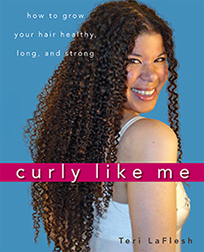
Available now!
Curly Like Me, the off-the-grid, do-it yourself owner's manual for tightly curly hair, is ready for ordering. Grab your copy today!

Every purchase made from
this site (through Amazon)
helps support it — and it
doesn't cost you anything
extra.
|
|
In the ingredient descriptions: Good means that I like to see this in a product's list of ingredients. Okay means this product appears safe for a curly person like me to use. Caution means that this ingredient may not be good in some hair care products, or for some people. Avoid means this ingredient may hurt your hair. If you see this ingredient in a hair product, it's best to put it down and walk away.
|
|
| |
Panthenol
(aka Pantothenic acid, Vitamin B5; Pro-vitamin B5)
Good
Panthenol is a form of vitamin B. Functions as a hair conditioner only. Works better in a leave-in product because otherwise it’s easily rinsed away. Can moisturize the hair to make it feel softer. Pantotheric acid is able to penetrate deeply into the cortex of the hair, but it is not able to repair hair, nor make hair strands thicker [Begoun Pgs 75, 85].
Per Johnson [pages 81-82], panthenol converts to panthothenic acid on the hair, which penetrates into the cortex and may help repair hair. But this is when it was used directly on the hair in a 5% solution. However, nothing, not even panthenol, will repair hair that's damaged in any meaningful way or help it grow longer once it's been hurt. The only way to repair damage and grow long healthy hair is to prevent hurting it in the first place. Otherwise, it's easy to feel like you can do anything to your hair and then pay lots of money for a product that promises to repair hair and it will fix everything you've done. It won't, and all you're left with is less money and damaged hair.--T
Per Hunting [(Conditioning) pages 307-308], this is included in products for conditioning and sales appeal (because it's a natural ingredient). Okay, I'm going to geek out a bit here. Interestingly, there are two forms of panthenol, a D-form and a DL-form, and only the D-form has vitamin activity. Products often include both forms. The D-form is a thick liquid that absorbs water, while the DL-form is a white, crystalline powder, that dissolves in water. Per Hunting, Panthenol is actually the DL-form. Panthenol is a provitamin, which means it's used to create pantothenic acid, which is what actually does the work on your hair. It is supposed to increase pliability and luster on the hair. Per Hunting, though there are many patents for panthenol out there, it is by no means certain that applying panthenol to hair by a conditioning rinse has a beneficial result.
See also:
Panthothenic acid
Source(s):
Begoun Hunting Johnson
|
|
References:
Applewhite, Thomas H., ed. Proceedings of the World Conference on Lauric Oils: Sources, Processing, and Applications
AOCS Publishing, 1994.
Barel, André O., Marc Paye, and Howard I. Maibach., eds. Handbook of Cosmetic Science and Technology, Second Edition
Marcel Dekker, Inc., 2001.
Begoun, Paula. Don’t Go Shopping for Hair-Care Products Without Me. 3rd Edition.
Renton: Beginning Press, 2005.
Begoun, Paula. The Beauty Bible.
Renton: Beginning Press, 2002.
Begoun, Paula. Don’t Go to the Cosmetics Counter Without Me.
Renton: Beginning Press, 2003.
Bellum, Sarah, ed. The Beauty Brains: Real Scientists Answer Your Beauty Questions
New York: Brains Publishing, 2008.
Gottschalk, Tari E. and McEwen, Gerald N, Jr. PhD, eds. International Cosmetic Ingredient Dictionary and Handbook, Tenth Edition 2004, Volumes 1-4.
Washington D. C.: The Cosmetic, Toiletry, and Fragance Association, 2004.
Halal, John Hair Structure and Chemistry Simplified, Fifth Edition
Albany: Milady, 2002.
Hunting, Anthony L.L. Encyclopedia of Conditioning Rinse Ingredients.
Cranford, NJ: Micelle Press, Inc., 1987.
Hunting, Anthony L.L. Encyclopedia of Shampoo Ingredients.
Cranford, NJ: Micelle Press, Inc., 1983.
Johnson, Dale H. (Ed.). Hair and Hair Care, Cosmetic Science and Technology Series. Vol. 17.
New York: Marcel Dekker, 1997. Print.
Nnanna, Ifendu A. and Jiding Xia., eds. Protein-Based Surfactants: Synthesis: Physicochemical Properties, and Applications (Surfactant Science)
Madison Heights: CRC, 2001.
Quadflieg, Jutta Maria. Fundamental properties of Afro-American hair as related to their straightening/relaxing behaviour.
Diss. U of Rheinisch-Westfälischen Technischen Hochschule Aachen, 2003.
Schueller, Randy and Perry Romanowski, eds. Conditioning Agents for Hair and Skin.
New York: Marcel Dekker, Inc., 1999.
Winter, Ruth M.S. A Consumer's Dictionary of Cosmetic Ingredients: Complete Information About the Harmful and Desirable Ingredients Found in Cosmetics and Cosmeceuticals
New York: Three Rivers Press, 2005.
Zviak, Charles., ed. The Science of Hair Care (Dermatology)
New York: Marcel Dekker, Inc., 1986.
|
|